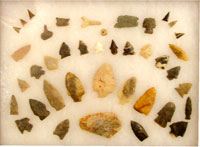The Wears and the Selfs - two family names that are common in these parts - are the corner stones of what later became the city of Clay. While structures are the most visible part of a community's history, the residents in the area know the longer-lasting legacies of a community's beginnings are in the relationships of the people. Family friendships, connecting through churches and intertwining through marriage, create strong bonds over multiple generations. This is Clay's 194-year history.
 The Indians were the first to leave human footprints on the reddish soil we have here. No doubt, they were attracted by the springs and abundant wildlife. The chirt in this area provided material for arrowheads, which are still found all over Clay. One local resident has found evidence of an Indian village dating to the Woodland period just south of Cosby Lake.
The Indians were the first to leave human footprints on the reddish soil we have here. No doubt, they were attracted by the springs and abundant wildlife. The chirt in this area provided material for arrowheads, which are still found all over Clay. One local resident has found evidence of an Indian village dating to the Woodland period just south of Cosby Lake.
Surrounding communities, including Argo, Cedar Mount and Ayres, had colonial settlers before Clay. Ayres is on the north end and most of it is .... Read more
Revolutionary War solder Samuel Wear settled in Clay by way of Cedar Mount. Many of his decendants are still here. His grave in the city's 1800s .... Read more
In time, the post offices came. Ayres, which later was called "Mt. Calvary" and sometimes called "Clayton's Cove," was the first in all the .... Read more
The story of Clay's history cannot be told without relating that Clay used to be a place for nature tourism. Alabama Caverns, later known as McCluney's Cave and Crystal Cave, attracted sight-seers from .... Read more
The area was so beautiful, a prominent general decided to build his summer home on 600 acres here. The big home and cottages had a unique Japanese style. In 1903, he sold the property to the State of Alabama to become a training facility for delinquent girls. That property, with new buildings, is southwest of Cosby Lake. The buildings received damage in a 2012 tornado and the state has not yet determined its future use.
Urban sprawl and the natural beauty, along with an expansion of the sewer system, brought increased development to the Clay community. The residents wanted to protect the area's unique lifestyle, so they voted to form a city in June 2000. After that, the city quickly grew from development and annexations.
The city of Clay works closely with the Clay Historical Society.